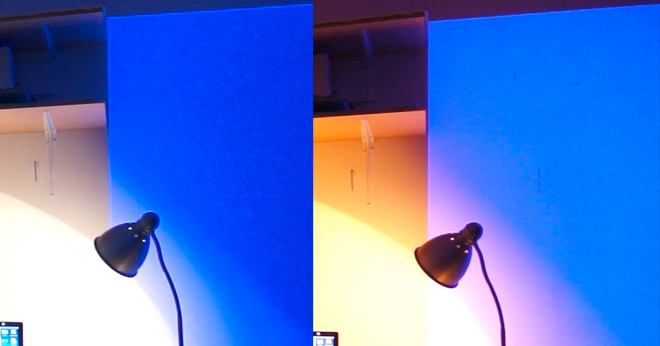Occasionally you stumble on something completely unexpected.
It’s great when this happens. The 5Ds and 7Ds, workhorses of the DSLR world, have nothing more to give; the lure and mystique of those early days in 2009 have all but vanished. The Sony NEX 5N however is different. A tempting new mistress who has yet to remove her makeup and demand you clean crusty left-over fries from the oven. I’ve only had the camera a few days I am still discovering new things about operating it and optimising the image. Usually the obvious stuff hits you first and then the smaller incidental bits. Well, I thought I’d try out the Sunset picture profile and I’m glad I did.
What a difference!!
One of the biggest flaws in DSLR codecs all but gone, in one fell swoop of the finger.
Until now DSLR image processors and codecs have been incredibly poor at rendering a smooth gradation of shades over flat areas with little detail.
We have tended to get banding and rough step-changes between different tones rather than a smooth gradient. We’ve had blockiness, poor colour rendition, plastic skin tones and blue skies that look like a huge hole in the ozone layer has just opened up.
Usually you can also see the effect on painted walls, on shadows and in low contrast areas, especially if there is a slight vignette and light fall off from the lens wide open. It’s particularly bad in motion since the banding pattern can hang statically over the image moving underneath it in such an unnatural and electronic manner, forget moire – this is the least cinematic property of DSLRs by a long shot and it is one of the reasons we have 10bit 4-4-4 colour on more expensive digital cinema cameras instead of 8bit.
The 5N’s Sunset picture profile is designed to give smooth gradated tones to mimic the look of 10bit on an 8bit codec.
This is the first time such a DSLR picture profile has been made this way and the results are stunning. Yes it is a consumer feature, for tourists to shoot nicer skies. And yes as you’d expect it does give a image and accentuate scarlets but you can compensate this with a cooler white balance or in your grading. I actually prefer a warmer image for 80% of what I do anyway.
The effect is stark with colour and tonal range both getting a nice boost. It even improves aliasing on hard edges of colour which was one of the weak points of the 5N, it’s nice to see it reduced.
On the left is the Standard picture profile and on the right is Sunset. Note that the orange glow of the desk light is how one’s eye actually sees it and the Standard mode gives you that clinical scientifically ‘correct’ white balance that I hate, which ignores the colour temperature of your various light sources completely. Sony and Panasonic have always been bad for this, Canon much better.
As you can see the difference in the smoothness of gradation and in the overall image is clear to see. All the blockiness on the projected blue image has gone, and it also fixes a major 5N flaw visible on the blue projection which is best illustrated in the video above rather than with words… you will know when you see it!

With the transition from a very cold light source to a very warm one, it is done far more smoothly and more naturally on the Sunset frame grab. Look also to the purple gradation behind the lamp on the Sunset profile shot, and how much more natural that is to the harsher one with Standard profile. In Standard the gradation has banding to the right and a harsh step between the blown out area of light to the right and the blue screen.
Both stills above are 1:1 crops from the AVCHD 25p FX mode.
The aliasing on the edge of the projection top and middle is also reduced with sunset, and it appears as a hard light blue line with all the other picture profiles.
The picture profile can be further optimised, with contrast lowered to improve shadow details and for further smooth gradation, sharpness reduced to further help aliasing and colour can be dialled down if it’s too strong for the scene. But I haven’t done enough experimentation here to see to what extent these further settings change the image for the better.
My next step is to dial down the warmness of the image for general use on a wide range of scenes, and when I finalise these settings I’ll do a blog on it.
By no means is this final – I need to shoot more with Sunset mode and see whether there are unforeseen side effects and to see just how far the warmness of the image can be reeled back in for situations where it isn’t preferable. It certainly appears a lot more cinematic and it fixes so much about the image. Colours are vivid and natural. If it works in all situations it will be staying as my default picture profile on the 5N for quite some time to come.
Disclaimer: It is necessary to compensate for the extreme warmth of this picture profile by adjusting white balance manually.
Recommended NEX 5N picture profile settings coming soon.



